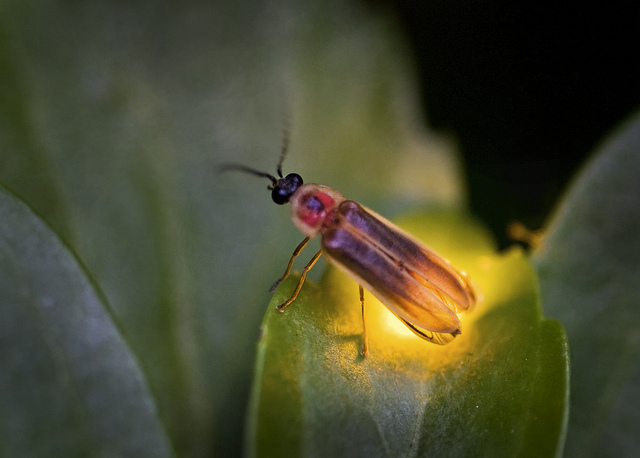Fireflies are fascinating creatures known for their enchanting glow, which lights up warm summer evenings in many parts of the world. But have you ever wondered, why do fireflies glow? In this article, we’ll explore the science behind firefly bioluminescence, what makes fireflies emit light, and the purpose behind this fascinating natural phenomenon. Understanding the biology of fireflies and the role of their glow helps us appreciate their unique behavior.

Bioluminescence is the production and emission of light by living organisms, and fireflies are one of the most well-known examples. Unlike other natural light sources, firefly glow doesn’t require heat, making it a highly efficient form of light production. The glow is produced through a chemical reaction in the firefly's body.
The chemical reaction responsible for firefly bioluminescence occurs in a special light-producing organ located in the abdomen of the firefly. This organ contains a compound called luciferin, which reacts with oxygen in the presence of an enzyme called luciferase. Here's how the process works:
Luciferin combines with oxygen, facilitated by the enzyme luciferase, to produce light.
The reaction occurs in the presence of ATP (adenosine triphosphate), which provides energy to the reaction.
This process is known as oxidative light emission and produces a cold, visible glow without generating heat.
Fireflies glow for a variety of reasons, but the primary purpose of their light is related to reproduction. Here’s why fireflies light up:
Mating Signals: The most common reason for fireflies to glow is to attract mates. Different species of fireflies use distinct patterns of flashes, with males often emitting light in a series of flashes, while females respond with a specific pattern of light in return. This helps potential mates identify each other from a distance.
Predator Avoidance: Some species of fireflies use their glow as a form of defense. By flashing brightly, they signal to predators that they may be toxic or distasteful. This warning is similar to the "aposematic" coloration found in other animals, such as brightly colored frogs or insects.
Communication: In addition to mating and defense, some firefly species use their glow to communicate with others in their group. This could include synchronizing their flashing patterns or warning others about potential dangers.
Different species of fireflies exhibit a wide range of glowing behaviors, with variations in the color, intensity, and pattern of light. Some species use constant glowing, while others produce rhythmic flashes. The diversity of glowing behaviors is crucial for species identification and mating rituals.
Color: Firefly light is usually green, yellow, or pale orange, though some species produce blue-green or reddish light.
Intensity and Duration: The duration of each flash can vary from a few milliseconds to several seconds, and the intensity can range from a faint glow to a very bright flash.
Flash Patterns: Some species flash in specific patterns to attract mates, while others may have continuous glowing or rapid bursts of flashes. For example, the synchronous fireflies of the Great Smoky Mountains produce synchronized light shows, where thousands of individuals flash in unison.
Fireflies typically emit light during warm, humid summer nights. The environmental conditions play a significant role in their glowing behavior. Several factors affect firefly activity, including:
Temperature: Fireflies are more active in warmer temperatures. Cold weather reduces their metabolic rate, and they may become dormant or less likely to glow.
Humidity: Humid environments are more conducive to firefly activity, as they require moisture to thrive. The high humidity also helps preserve the integrity of the bioluminescence process.
Light Pollution: Artificial light, such as streetlights and city lights, can interfere with fireflies’ ability to communicate using their glow. This is why fireflies are most commonly seen in rural or wooded areas where natural darkness is prevalent.
In addition to their enchanting glow, fireflies play an important role in the ecosystem. Fireflies help regulate insect populations, as they feed on small insects like ants, snails, and other invertebrates. Firefly larvae are also predatory and hunt invertebrates in the soil. By controlling these populations, fireflies contribute to maintaining a healthy balance in the ecosystem.
So, why do fireflies glow? The primary reasons are for attracting mates, protecting themselves from predators, and communicating with others in their species. The chemistry behind firefly bioluminescence is an extraordinary natural process that produces cold light, which is both energy-efficient and mesmerizing. The glow of fireflies serves as a crucial tool in their reproductive cycles and survival strategies, making them an integral part of nature.
Understanding the science behind firefly bioluminescence not only fascinates us but also deepens our appreciation for these beautiful insects. Protecting firefly habitats from pollution and light disruption is essential for preserving their role in ecosystems and ensuring that future generations can enjoy their stunning, glowing displays.
The Role of Fireflies in Ecosystems
How to Attract Fireflies to Your Garden
The Chemistry of Bioluminescence: A Deeper Dive into Natural Light Sources
Fireflies are more than just a beautiful spectacle—they are a testament to the complexity and wonder of nature.
animal tags: Fireflies
We created this article in conjunction with AI technology, then made sure it was fact-checked and edited by a Animals Top editor.